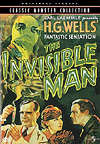The Invisible Man
Universal Home Video
Cast: Claude Rains, Gloria Stuart, Una O’Connor
Extras: Commentary Track, Documentary, Photo Gallery, Production Notes, Cast & Crew Biographies
Rating:
Universal Studios Home Video releases yet another meticulous chapter in the preservation of their cultural legacy. James Whale’s 1933 film adaptation of the H.G. Wells science fiction classic "The Invisible Man" materializes on DVD with a wealth of features including a very thorough <$commentary,commentary track> by historian Rudy Behlmer, a documentary chronicling the "invisible" phenomenon throughout the movies, anchored by a very respectful audio and video presentation. Gaze into the heart of "The Invisible Man" and journey into the mechanics of ego itself.
His disappearance distresses his colleague Dr. Cranley (Henry Traverse, better known as Clarence the angel from "It’s A Wonderful Life") and his daughter Flora (Gloria Stuart, last seen as the senior Rose in James Cameron’s "Titanic"). Both suspect that his secret experiments have something to do with the strange reports of an "invisible man" wreaking havoc in a nearby town. Meanwhile, another associate, Dr. Kemp (William Harridan), seizes the opportunity to make advances towards Flora, although she declares her love for Jack.
Kemp tips the police to Griffin’s desires. Methodical dragnets attempt his capture. Griffin retaliates by tormenting bystanders as well as delivering comeuppance for those whom he believes have betrayed him. The police slowly close in, eventually bringing Griffin to a reckoning with himself, his loved ones and the unseen forces he sought to conquer.
Screenwriter R.C. Sherriff adapts Wells’ cautionary tale with compassion and economy. The film is a lean 71 minutes in running time, but quite muscular in terms of thematic exploration. We recognize Griffin’s desires (who wouldn’t want complete control over their destiny?), but shudder at how it destroys his ability to grasp reality. His life becomes a series of contradictions. He’s intoxicated with his newfound power, but longs for a return to his former visible self. He uses his condition to steal money from banks and give to the poor, but thinks nothing of sending a train full of commuters to a fiery end. In his quest for knowledge, he used elixirs that render the user insane.
What makes "The Invisible Man" (and the other great monster films for that matter) so compelling is that it speaks to that disenfranchised part of our psyches. We all have moments of displacement, of feeling separate. The image of the bandaged Griffin, his hands clasping his head in frustration is an archetypal picture that we all have painted ourselves. In those moments of fear and anger, we wait for some kind of transformation or reinvigoration that will remove our impotence. Metaphorically, it might be from man to wolf, from living to undead, from visible to invisible. Like the great myths, the odysseys of Jack Griffin or Dr. Frankenstein or Lawrence Talbot continue through the ages and we never seem to learn from their mistakes.
An impressive 35 minute documentary "Now You See Him: ’The Invisible Man’ Revealed" spends as much time documenting the career of James Whale as much as examining the genesis of the film as well as other invisibility-themed movies over the last 60 years. An impressive number of on-camera participants add their insights including Ian McKellan, film historians Rudy Behlmer and David J. Skal (THE Universal horror film guru), director Bill Condon ("Gods and Monsters"), Whale confidant and director Curtis Harrington ("Night Tide") and Claude Rains’ daughter Jessica Rains. Among the revelations: no less than 12 writers, including John Huston and Preston Sturges, and four directors were involved at one point during the book to film translation process. The documentaries for the Universal Monster DVDs have been the most consistently entertaining for me. No doubt due to my affinity for the material, I’ve found them all thoroughly researched, briskly paced and imbued with a genuine love for the material.
Film historian Rudy Behlmer’s <$commentary,commentary track> expands on the information provided in the documentary. Either through careful editing or Behlmer’s inexhaustible energy, the commentary is wall to wall during the entire running time and never flags once. Behlmer comprehensively details the circumstances that surround the making of the film. He quotes from trade journals about how Karloff walked away from Universal and the title role in "Invisible." He cites freely from John P. Fulton’s article in the June 1934 issue of American Cinematographer about the achieving of the invisibility effects. (He even points out how the footprints in the snow are shaped like shoe outlines, not bare feet.) Behlmer also tackles the actors with equal relish, practically affording a mini-biography for practically every cast member. A bit dry, you might think. Not at all. Rudy delivers authoritatively and, again, with much admiration for the material.
This review has turned out a little more personal than I intended. One of the reasons I love the movies is because of the group efforts of a bunch of geniuses at a small studio nestled in the San Fernando Valley during the 1930s. Whenever I see horror confused with shock, as in so many monster classic remakes/updates, my dander stirs. Horror lingers in the mind long after the avalanche of zeros and ones abates.
P.S.: I also highly recommend Kevin Brownlow’s marvelous documentary "Universal Horror." Premiered on Turner Classic Movies two years ago, it touches upon some of the themes mentioned in this review as well as other undercurrents in the films including reactions to the carnage of WWI (Griffin’s bandaging and goggles are a clear evocation of that). If I’m not mistaken, TCM re-plays it every Halloween.







